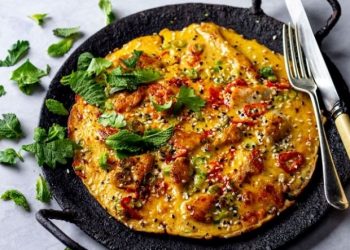8 servings
Prep: 45 mins,
Cooking: 1 hr 30 mins
A crown roast of lamb prepared using the reversed searing method. Stuffed with couscous, cranberries and pistachios. Served with a mint infused sauce and a fresh watercress salad.
Rate this recipe
Recipe Disclaimer
Tap for method
Ingredients (24)
Lamb
| 2 x I kg | racks of lamb — chined [spine bone removed by the butcher] (x 6-8 ribs per rack of lamb tied together) refer to notes on how to assemble the crown roasts of ask butcher to prepare |
| 2 tbsp | olive oil |
| 2 tsp | salt |
| 1 tsp | black pepper |
| 2 | garlic cloves — finely chopped |
| 2 tbsp | fresh oregano — roughly chopped |
| 2 tbsp | fresh rosemary — roughly chopped |
Stuffing
| 1 cup | lamb stock |
| 1 tsp | ground turmeric |
| 1 cup | couscous — uncooked |
| 1 tbsp | olive oil |
| 1/2 cup | dried cranberries |
| 1/2 cup | spring onions — thinly sliced |
| 2 tbsp | fresh parsley — chopped |
| 1/2 cup | pistachios — chopped |
| 1/2 tsp | salt |
| 1/2 tsp | pink peppercorns — crushed |
Sauce
| 1 1/2 cup | lamb stock |
| 1/2 cup | rosé wine |
| 2 tbsp | flour |
| 1 tbsp | butter |
| 1/2 tsp | salt |
| 1/2 tsp | black pepper |
| 1/2 cup | fresh mint leaves |
Tap for ingredients















